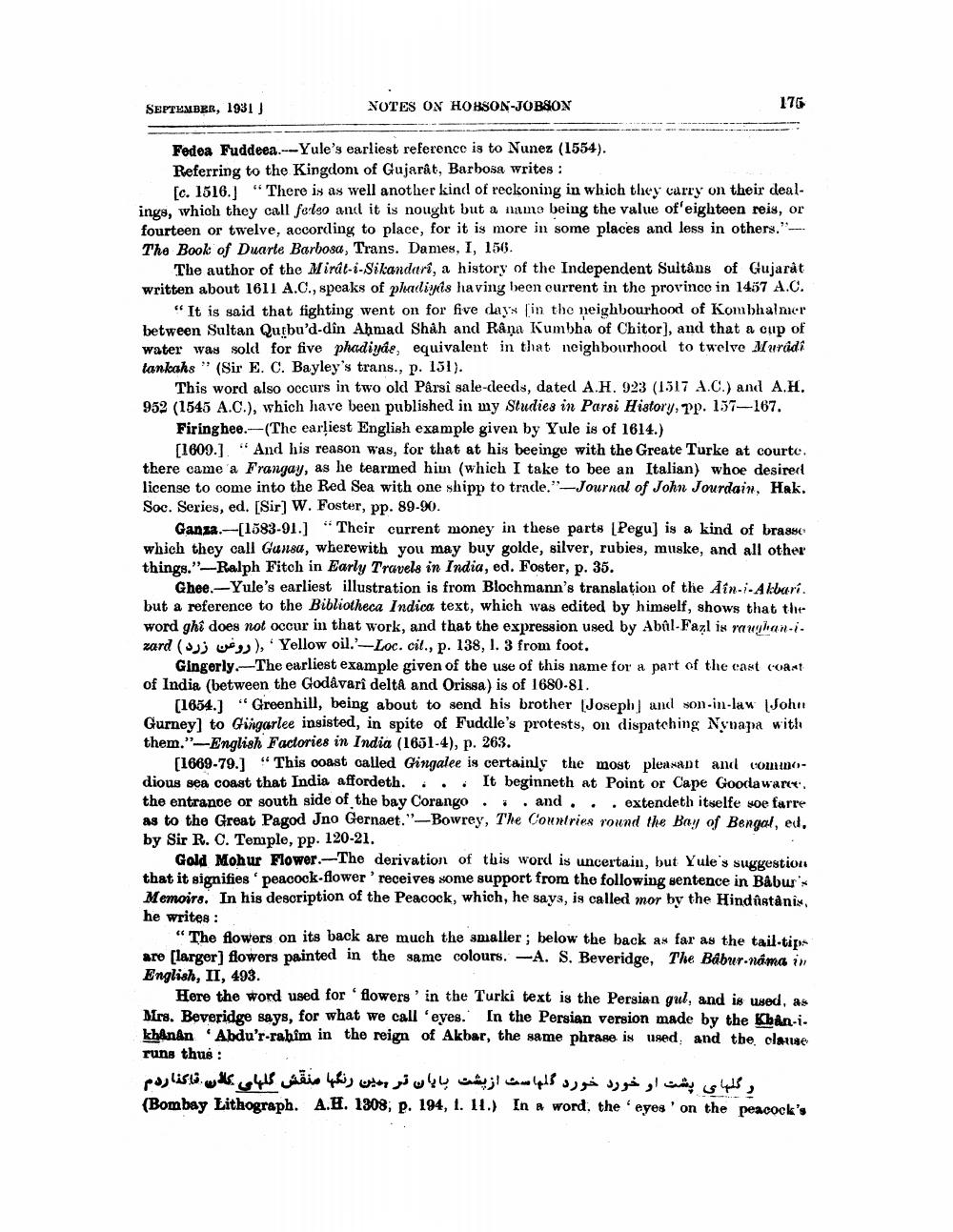________________
SEPTEMBER, 1931)
NOTES ON HOBSON-JOBSOX
176
Fedea Fuddeea.--Yule's earliest reference is to Nunez (1554). Referring to the Kingdom of Gujarat, Barbosa writes :
fc. 1516.1 "There is as well another kind of reckoning in which they carry on their dealings, which they call ferlso and it is nought but a name being the value of eighteen reis, or fourteen or twelve, according to place, for it is more in some places and less in others.'-. The Book of Duarte Barbosa, Trans. Dames, I, 156.
The author of the Mirát--Sikandari, a history of the Independent Sultans of Gujarat written about 1611 A.C., speaks of phadiris having been current in the provinco in 1457 A.C.
“It is said that fighting went on for five days in the neighbourhood of Kombhalmer between Sultan Qutbu'd-din Ahmad Shah and Råna Kumbha of Chitor), and that a cup of water was sold for five phadiyde, equivalent in that neighbourhood to twelve Muridi tankahs" (Sir E. C. Bayley's trans., p. 151).
This word also occurs in two old Pârsi sale-cleeds, dated A.H. 923 (1517 A.C.) and A.H. 952 (1545 A.C.), which have been published in my Studies in Parsi History, pp. 157-167.
Firinghee.-(The earliest English example given by Yule is of 1614.)
11609.) "And his reason was, for that at his bee inge with the Greate Turke at courte. there came a Frangay, as he tearmed him (which I take to bee an Italian) whoe desirert license to come into the Red Sea with one shipp to trade."-Journal of John Jourdain, Hak. Soc. Series, ed. [Sir] W. Foster, pp. 89-90.
Ganza.--[1583-91.] “Their current money in these parts [Pegu] is a kind of brasse which they call Gunsu, wherewith you may buy golde, silver, rubies, muske, and all other things.'-Ralph Fitch in Early Travels in India, ed. Foster, p. 35.
Ghee.--Yule's earliest illustration is from Blochmann's translation of the Ain-i-Akbari. but a reference to the Bibliotheca Indica text, which was edited by himself, shows that the word ghi does not occur in that work, and that the expression used by Abûl-Fazl is raughan.. zard ( w ), Yellow oil.'--Loc. cit., p. 138, 1. 3 from foot.
Gingerly-The earliest example given of the use of this name for a part of the cast coast of India (between the Godavari deltå and Orissa) is of 1680-81.
(1654.) “Greenhill, being about to send his brother (Joseph, and son-in-law (John Gurneyl to Gingarlee insisted, in spite of Fuddle's protests, on dispatching Nynapa with them."-English Factories in India (1651-4), p. 263.
11669-79.) “This coast called Chingalee is certainly the most pleasant and comdious sea coast that India affordeth. .. It beginneth at Point or Cape Goodawaret, the entrance or south side of the bay Corango. . and ... extendeth itselfe soe farre as to the Great Pagod Jno Gernaet."-Bowrey, The Countries round the Bay of Bengal, ed, by Sir R. C. Temple, pp. 120-21.
Gold Mohur Flower --The derivation of this word is uncertain, but Yule's suggestion that it signifies' peacock-flower 'receives some support from the following sentence in Babur Memoirs. In his description of the Peacock, which, he says, is called mor by the Hindîstanis, he writes :
« The flowers on its back are much the smaller ; below the back as far as the tail-tips are [larger) flowers painted in the same colours, A. S. Beveridge, The Babur-nama in English, II, 493.
Here the word used for 'flowers' in the Turki text is the Persian gul, and is used, as Mrs. Beveridge says, for what we call 'eyes. In the Persian version made by the Kbån.i. khanan Abdu'r-rahim in the reign of Akbar, the same phrase is used and the clause runs thus :
ر گلهای پشت او خورد خورد گلها ست از پشت پایان ترین رنگها منقش گلهای کلان قايناردم
(Bombay Lithograph. A.H. 1308, p. 194, 1. 11.) In a word, the 'eyes' on the peacock's




